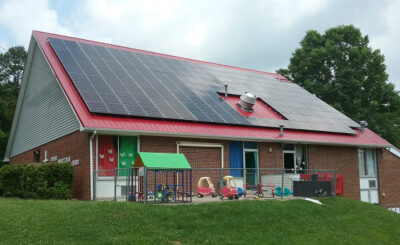Front Porch Blog


According to a report by the Energy Information Administration, close to one-third of Americans struggle to pay their energy and heating bills, with many having to choose whether to prioritize energy or other necessities like food or medicine. This same study shows that in 2015, African-American families reported 20% more energy insecurity compared to white families.
Black and rural households also spend more on energy than other Americans. Often, these communities are also subjected to the consequences of fossil fuel energy production with excess air, water and soil pollution leading to negative health impacts.
These stark disparities in accessibility and affordability of energy have become even more apparent during the current pandemic. Compounding the anxieties of the coronavirus, many families in these more vulnerable communities have to worry about having their electricity or gas cut off. Research also shows that air pollution from fossil fuels exacerbates Covid-19 symptoms and puts people more at risk.
A new report released by Synapse, the Regulatory Assistance Project, and Community Action Partnership, along with support from the Robert Wood Johnson Foundation, examines the economic, social and health disparities associated with energy infrastructure development,
and proposes opportunities for policymakers to help achieve a more equitable future in transitioning to clean energy.
The national report highlights the most promising points of intervention to reduce inequity in clean energy.

The solar panels at Spencer Presbyterian Church. Photo courtesy of Brenda Wilson
- Improving Affordability of Energy: Help low-income and frontline communities afford new clean technologies such as energy efficiency measures in the home, renewable energy, battery storage, and efficient electrification without any disproportionate costs.
- Improving Access to Energy: Protect customers against service shutoffs when they are unable to pay their utility bills. (Appalachian Voices is working with partners throughout the region to press utilities and state officials to enact and expand moratoriums on utility service shutoffs during the Covid pandemic, and to institute more permanent protections for economically vulnerable families.) Invest in energy resources that can be distributed in rural communities, such as solar and battery-storage systems.
- Reducing Environmental Hazards: Strengthen environmental regulations to value clean technologies. Promote the storage of clean energy to build resilience against power grid outages.
- Promoting Employment: Target job training to increase cultural and gender diversity in clean energy jobs. Provide a path for communities economically dependent on fossils fuels to transition to clean energy.
The study details specific case studies from across the country that have shown encouraging results when states invest in these points of intervention.
- Bloomfield, Iowa: Better resource planning and investments in solar and energy efficiency are reducing costs for residents and leading to local economic development.
- Ohio: A statewide arrearage management program is helping to protect low-income customers from utility shut-offs.
- Minnesota: Xcel Energy and the Minnesota Public Utilities Commission are implementing performance-based regulation that improves affordability, customer service quality and workforce diversity.
- Northeastern US: Through the Regional Greenhouse Gas Initiative (RGGI), energy and environmental regulators are working together to improve health and conditions of communities by reducing carbon dioxide emissions from power plants by more than 50 percent.
The problems and inequities that vulnerable communities face in the energy sector are complex and there is no single solution. However, there has never been a better time to fix these issues, as the energy sector is changing rapidly and new, clean technologies such as energy efficiency, demand-side management and renewable energy like solar are becoming more affordable. States are also starting to encourage replacing technologies reliant on fossil fuels with efficient electrification and cleaner energy.
Through investing in these specific areas and targeting those investments most heavily in disadvantaged communities, we have the opportunity to reduce the current inequity in the energy sector and move towards a cleaner future that does not leave any communities behind, whether they be low-income, rural or communities of color.
The full Synapse report can be found here.
PREVIOUS
NEXT

Leave a comment
Your email address will not be published. Required fields are marked *

Leave a Comment